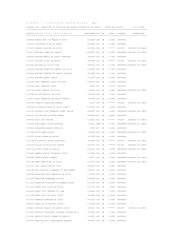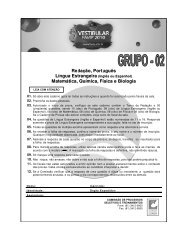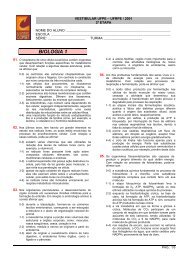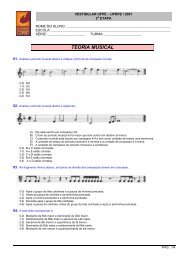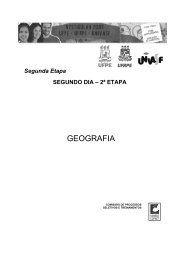Segunda Etapa Teoria Musical Inglês - Covest
Segunda Etapa Teoria Musical Inglês - Covest
Segunda Etapa Teoria Musical Inglês - Covest
You also want an ePaper? Increase the reach of your titles
YUMPU automatically turns print PDFs into web optimized ePapers that Google loves.
LEIA COM ATENÇÃO<br />
Nome: Inscrição:<br />
Identidade: Órgão Expedidor:<br />
Assinatura:<br />
<strong>Segunda</strong> <strong>Etapa</strong><br />
<strong>Teoria</strong> <strong>Musical</strong> <br />
<strong>Inglês</strong> <br />
01. Só abra este caderno após ler todas as instruções e quando for autorizado pelos fiscais da sala.<br />
02. Preencha os dados pessoais.<br />
03. Autorizado o início da prova, verifique se este caderno contém 32 (trinta e duas) questões. Se não estiver<br />
completo, exija outro do fiscal da sala.<br />
04. Todas as questões desta prova são de proposições múltiplas e apresentam 5(cinco) alternativas<br />
numeradas de duplo zero (0-0) a duplo quatro (4-4), podendo ser todas verdadeiras, todas falsas ou<br />
algumas verdadeiras e outras falsas. Na folha de respostas, as verdadeiras devem ser marcadas na<br />
coluna I (das dezenas); as falsas, na coluna II (das unidades).<br />
05. Ao receber a folha de respostas, confira o nome da prova, o seu nome e número de inscrição. Qualquer<br />
irregularidade observada, comunique imediatamente ao fiscal.<br />
06. Assinale a resposta de cada questão no corpo da prova e, só depois, transfira os resultados para a folha<br />
de respostas.<br />
07. Para marcar a folha de respostas, utilize apenas caneta esferográfica preta e faça as marcas de acordo<br />
com o modelo ( ) . A marcação da folha de respostas é definitiva, não admitindo rasuras.<br />
08. Não risque, não amasse, não dobre e não suje a folha de respostas, pois isto poderá prejudicá-lo.<br />
09. Os fiscais não estão autorizados a emitir opinião nem a prestar esclarecimentos sobre o conteúdo das<br />
provas. Cabe única e exclusivamente ao candidato interpretar e decidir.<br />
10. Se a Comissão verificar que a resposta de uma questão é dúbia ou inexistente, a questão será<br />
posteriormente anulada e os pontos a ela correspondentes<br />
COMISSÃO DE PROCESSOS<br />
SELETIVOS E TREINAMENTOS<br />
Fone: (81) 3231-4000<br />
Fax: (81) 3231-4232
<strong>Teoria</strong> <strong>Musical</strong><br />
01. Quais as fórmulas de compasso indicadas para o período musical abaixo?<br />
0-0) 6/8<br />
1-1) 3/8<br />
2-2) 4/8<br />
3-3) 2/8<br />
4-4) 2/4<br />
02. O tom de Fá sustenido maior e seu relativo menor possuem armadura de tom com:<br />
0-0) 5 sustenidos<br />
1-1) 7 sustenidos<br />
2-2) 3 sustenidos<br />
3-3) 6 sustenidos<br />
4-4) 4 sustenidos<br />
03. Observe as afirmativas abaixo.<br />
0-0) 3/4 é um compasso ternário simples.<br />
1-1) 9/8 tem como unidade de tempo a colcheia.<br />
2-2) 2/2 tem como unidade de tempo a mínima.<br />
3-3) 12/16 é um compasso quaternário composto.<br />
4-4) 6/2 tem como unidade de tempo a mínima<br />
04. No fragmento musical abaixo, as barras de divisão dos compassos devem ser colocadas:<br />
0-0) após a primeira pausa de colcheia e antes da segunda pausa de colcheia.<br />
1-1) antes da primeira pausa de colcheia e após a segunda pausa de colcheia.<br />
2-2) após a primeira semínima e depois do grupo de três colcheias<br />
3-3) antes da semínima pontuada e após o grupo de três colcheias.<br />
4-4) somente após a semínima pontuada.<br />
05. A nota Mi corresponde, respectivamente, à:<br />
0-0) supertônica de Ré menor e sensível de Fá menor.<br />
1-1) dominante de Lá maior e Lá menor.<br />
2-2) subtônica de Fá maior e mediante de Si maior.<br />
3-3) subdominante de Si menor e mediante de Dó menor.<br />
4-4) mediante de Dó maior e dominante de Si maior.<br />
06. O tom de Ré bemol maior tem como vizinhos indiretos:<br />
0-0) Sol bemol maior e Si bemol menor.<br />
1-1) Mi bemol menor e Fá menor.<br />
2-2) Lá bemol maior e Sol bemol maior.<br />
3-3) Ré maior e Si menor.<br />
4-4) Sol maior e Mi menor.<br />
07. O tom de Sol sustenido menor tem como vizinhos diretos:<br />
0-0) Si maior e Ré sustenido menor.<br />
1-1) Mi maior e Fá sustenido maior.<br />
2-2) Dó sustenido menor e Ré sustenido menor.<br />
3-3) Fá sustenido maior e Si maior.<br />
4-4) Dó sustenido menor e Si maior.
08. O período musical abaixo está no tom de:<br />
0-0) Mi menor.<br />
1-1) Fá maior.<br />
2-2) Ré menor.<br />
3-3) Sol menor.<br />
4-4) Dó maior.<br />
09. São considerados relativos os tons de:<br />
0-0) Ré maior e Si menor.<br />
1-1) Mi menor e Sol maior.<br />
2-2) Sol menor e Mi bemol maior.<br />
3-3) Ré menor e Fá maior.<br />
4-4) Lá maior e Fá sustenido menor.<br />
10. São considerados homônimos os tons de:<br />
0-0) Sol maior e Mi menor.<br />
1-1) Lá bemol menor e Lá bemol maior.<br />
2-2) Sol bemol maior e Fá sustenido maior.<br />
3-3) Dó maior e Dó menor.<br />
4-4) Ré menor e Fá maior.<br />
11. São considerados enarmônicos os tons de:<br />
0-0) Ré bemol maior e Dó sustenido maior.<br />
1-1) Si bemol menor e Sol bemol maior.<br />
2-2) Mi bemol menor e Dó menor.<br />
3-3) Sol maior e Sol menor.<br />
4-4) Ré sustenido menor e Mi bemol menor.<br />
12. Analise as escalas e responda:<br />
A B<br />
C<br />
D<br />
0-0) A é uma escala menor melódica, e D uma escala menor natural.<br />
1-1) C é uma escala menor harmônica, e B uma escala maior.<br />
2-2) A e B são escalas maiores.<br />
3-3) C e D são escalas menores naturais.<br />
4-4) A é uma escala menor harmônica e B uma escala maior.<br />
Analise as tríades e responda às questões 13 e 14.<br />
A B C D E F G H<br />
13. São acordes perfeitos menores e estão no estado fundamental as tríades:<br />
0-0) B e E.<br />
1-1) A e D.<br />
2-2) B e C.<br />
3-3) F e H.<br />
4-4) C e E.
14. São acordes perfeitos maiores e estão na primeira inversão as tríades:<br />
0-0) H e G.<br />
1-1) D e E.<br />
2-2) B e F.<br />
3-3) A e C.<br />
4-4) D e H.<br />
15. Analise os acordes de quatro sons e responda:<br />
A B C D<br />
0-0) A e D são acordes de sétima de dominante.<br />
1-1) B e C são acordes de sétima diminuta.<br />
2-2) B e D são acordes de sétima da sensível do modo maior.<br />
3-3) A é um acorde de sétima de dominante e B um acorde de sétima diminuta.<br />
4-4) C é um acorde de sétima diminuta, e D um acorde de sétima da sensível.<br />
16. Analise a escala cromática de Sol maior. As notas cromáticas têm origem nos tons de:<br />
0-0) A Lá maior e B Si menor.<br />
1-1) C Ré maior e D Mi maior.<br />
2-2) B Si menor e E Fá maior.<br />
3-3) C Ré menor e D Mi menor.<br />
4-4) A Lá menor e E Dó maior.<br />
A B C D E
<strong>Inglês</strong><br />
Read the text carefully and answer items 17 to 24.<br />
YOUR BEST FRIEND<br />
“Forget keyboards and screens! The PC of<br />
the future might not only walk and talk<br />
but actively seek out human contact.<br />
Take NEC’s latest gizmo, the R-100<br />
personal-computer robot. Designed<br />
by Yoshihiro Fujita, a robotics<br />
engineer at NEC’s Incubation Center<br />
in Kawasaki, the R-100 is what you<br />
would expect to get by crossing a<br />
PC with a robot.<br />
The R-100 can understand<br />
rudimentary spoken commands. It<br />
can’t fetch your slippers, but it will<br />
access your e-mail when told and guard<br />
your house while you are away. Fujita,<br />
whose specialty is computer vision, has given the R-100<br />
keen eyesight and a deftness at recognizing patterns. With<br />
a Pentium-based computer-processing unit for a brain and<br />
two cameras for eyes, it can identify the faces of up to 10<br />
people at a time. Fujita has also provided the robot with<br />
high-sensivity micro-phones, so it can pick up the slightest<br />
sounds. This makes it a handy watchdog. It has sensors<br />
that allow it to react to your touch by emitting little yelps of<br />
approval. Fujita has even programmed the R-100 to<br />
search out human activity when it walks into a room,<br />
matching the faces it sees to those on its database. “It<br />
looks like a robot, but in fact it is a PC with cameras and<br />
wheels,” he says.<br />
Fujita wants the R-100 to be something more than merely<br />
a troublesome pet substitute. He wants it to be a great<br />
helper!”<br />
(From NEWSWEEK, September 18, 2001, pages 38-39)<br />
17. The topic idea of the text is that<br />
0-0) the R-100 personal computer was designed by<br />
Yoshihiro Fujita, a robotics engineer at NEC’s<br />
Incubation Center.<br />
1-1) people need to be trained on how to use<br />
keyboards and screens in an effective way.<br />
2-2) the R-100 is able to understand simple as well<br />
as complex language.<br />
3-3) the computer of the future might do ordinary<br />
human activities such as walking, talking and<br />
looking for human interaction.<br />
4-4) the computer of the future is what we would<br />
expect to achieve by crossing a PC with a robot.<br />
18. The computer R-100 can<br />
0-0) understand common simple spoken<br />
statements/sentences.<br />
1-1) go and get your sandals when you arrive back<br />
home.<br />
2-2) identify the facial features of up to ten people at<br />
a time.<br />
3-3) watch your house when you are not in.<br />
4-4) perceive any kind of sound.<br />
19. Fujita has provided the R-100 with<br />
0-0) a programmed unit to find out if your brain is<br />
functioning well.<br />
1-1) sensors that permit it to show rapid reaction to<br />
human singing.<br />
2-2) a processing unit for guessing your eyes’ shape<br />
and colour.<br />
3-3) a programmed unit to identify the presence of<br />
intruders in the house.<br />
4-4) sharp vision and a special ability to identify<br />
regularly repeated arrangements.<br />
20. The word “gizmo” in “Take NEC’s latest gizmo, ...”<br />
is similar to:<br />
0-0) substitution<br />
1-1) invention<br />
2-2) fashion<br />
3-3) affliction<br />
4-4) creation<br />
21. The R-100 computer can function as.<br />
0-0) a very special baby animal you can’t raise at<br />
home.<br />
1-1) an old and nice robot that keeps you company.<br />
2-2) a useful dog that can take care of/guard your<br />
house.<br />
3-3) a lovingly old friend that likes to play with<br />
cameras.<br />
4-4) a useless but funny machine which you like to<br />
play with.<br />
22. In “It has sensors that allow it to react to your touch<br />
by emitting little yelps of approval” the word “yelps”<br />
is equivalent to:<br />
0-0) words<br />
1-1) sounds<br />
2-2) whispers<br />
3-3) noisies<br />
4-4) songs<br />
23. The following sentences are both in the same verb<br />
form. Identify this verb form.<br />
“Forget keyboards and screens. .... Take NEC’s<br />
latest gizmo, the R-100 personal-computer robot”.<br />
0-0) Simple Present<br />
1-1) Imperative<br />
2-2) Future<br />
3-3) Gerund<br />
4-4) Past Simple<br />
24. The connective “so” in “Fujita has also provided the<br />
robot with high-sensivity microphones, so it can pick<br />
up the slightest sounds” can be substituted for:<br />
0-0) thus<br />
1-1) though<br />
2-2) therefore<br />
3-3) in fact<br />
4-4) for this reason
MY OWN PRIVATE RIO<br />
Bruno Barreto was deeply moved when he ________ a<br />
group of New York teenagers ________ The Wave, one of<br />
the boffo songs ________ by the late bossa nova luminary<br />
Tom Jobim. ________ Barreto, bossa nova meant the<br />
irreversible internalization of Brazilian music. After the<br />
tense Four Days in September, he switched back to the<br />
spirit of Dona Flor and her Two Husbands, ________ hit of<br />
the Brazilian movie industry, and gave his all to a romantic<br />
comedy, Bossa Nova. It stars his wife, Amy Irving, a<br />
teacher of English in an oneiric Rio de Janeiro ________<br />
falls in love with a pupil. In the US, it will premiere in 14<br />
states simultaneously.<br />
(From My own private Rio, by Carlos Moraes, ÍCARO Brasil, 188,<br />
April 2000, page 26.)<br />
25. Fill in the blanks with the correct sequence of words.<br />
0-0) hears – whistle – is being written – For –<br />
the great – where<br />
1-1) heard – whistling – written – To – the greatest –<br />
who<br />
2-2) has heard – whistles – have written – In –<br />
the greater – what<br />
3-3) will hear – to whistle – will be written – At –<br />
one of the greatest – whose<br />
4-4) would hear – whistled – had written – On –<br />
a greater – whom<br />
26. According to the text, Bruno Barreto’s Bossa Nova is:<br />
0-0) one of Jobim’s boffo songs.<br />
1-1) the spirit of Dona Flor and her two husbands.<br />
2-2) the irreversible internalization of Brazilian music.<br />
3-3) a successful venture of the Brazilian movie<br />
industry.<br />
4-4) a romantic comedy that takes place in Rio.<br />
27. In fact, Barreto’s Bossa Nova pays homage to:<br />
0-0) a love affair.<br />
1-1) an oneiric Rio de Janeiro.<br />
2-2) fourteen American States.<br />
3-3) Tom Jobim’s songs.<br />
4-4) New York teenagers.<br />
28. The comment “and gave his all to a romantic<br />
comedy”, in line 8, suggests that Barreto<br />
0-0) went bankrupt due to his work.<br />
1-1) committed himself to his work.<br />
2-2) concentrated himself in his work.<br />
3-3) got deeply involved in his work.<br />
4-4) aimed his efforts at his work.<br />
29. The sentence “Bruno Barreto was deeply moved”,<br />
in line 1, means that he was:<br />
0-0) very mutable.<br />
1-1) rather uneasy.<br />
2-2) extremely touched.<br />
3-3) highly impressed.<br />
4-4) somewhat hurt.<br />
TRIBES AND TRAILS<br />
An eco-tourism TV show has been just financed to<br />
publicize abroad magnificent destinations in Brazil – such<br />
as Fernando de Noronha, Chapada Diamantina and the<br />
Highlands of Rio Grande do Sul – in addition to everyday<br />
life of the inhabitants and daring sports activities.<br />
(From: Tribes and Trails. ÍCARO Brasil, 188, April 2000, page<br />
100.<br />
Select the correct choice(s) to answer items 30 to 32.<br />
30. The TV program entitled Tribes and Trails will<br />
broadcast some aspects of the Brazilian:<br />
0-0) regions<br />
1-1) tourism<br />
2-2) people<br />
3-3) culture<br />
4-4) sports<br />
31. The expression “such as”, in lines 2 and 3, can be<br />
substituted for:<br />
0-0) like<br />
1-1) unlike<br />
2-2) for example<br />
3-3) likewise<br />
4-4) likely<br />
32. “In addition to”, in line 4, is equivalent to:<br />
0-0) Besides<br />
1-1) Beyond<br />
2-2) Moreover<br />
3-3) Furthermore<br />
4-4) Also




